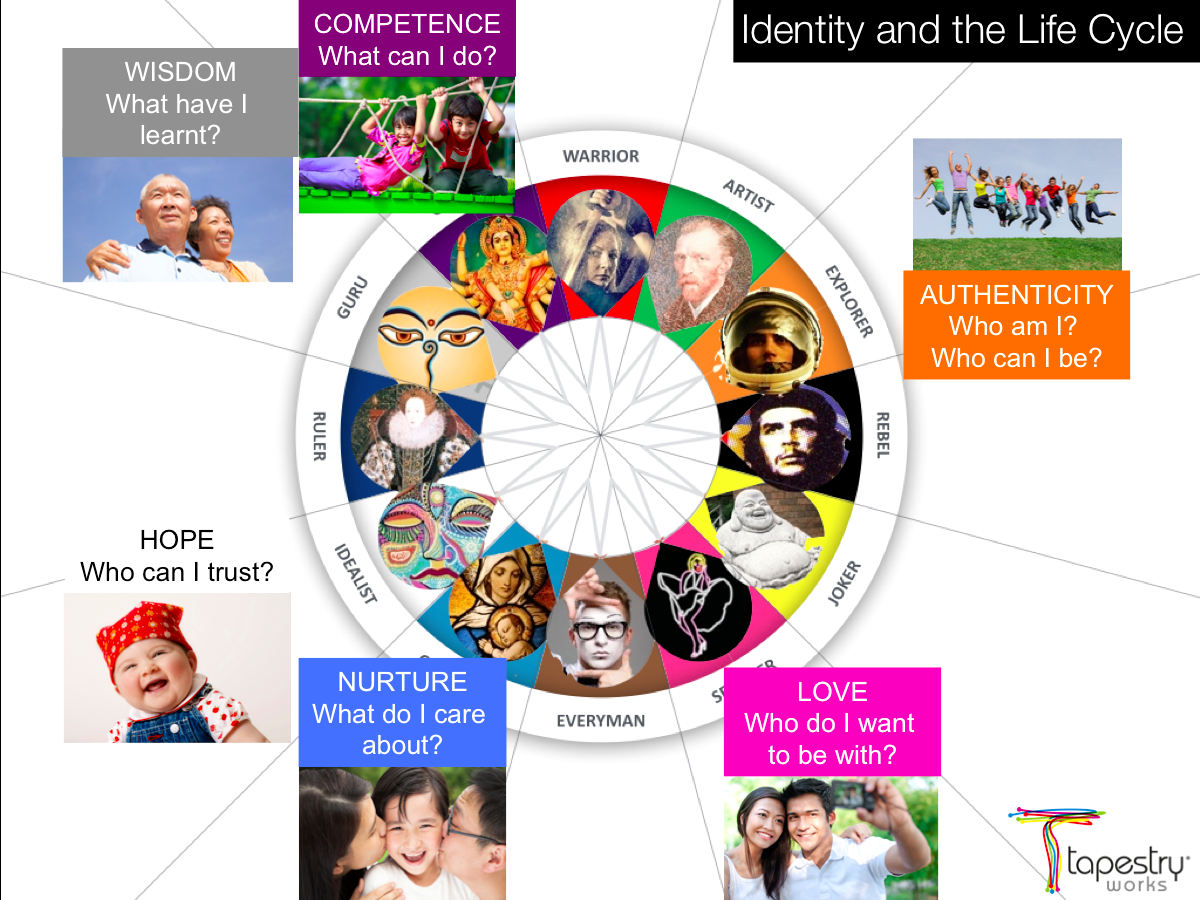In Identity and the Life Cycle and other works, Erik Erikson developed a lifespan model of human development covering eight stages, five in childhood and three in adulthood. His work is very much influenced by Sigmund Freud, although he focuses on psychosocial development rather than psychosexual. Erikson emphasises the role of society and culture, and the conflicts between individuals and their society and culture in shaping the way all humans develop through their life. In his model, each stage builds on the previous stages and the growth and trajectory of development shares a great deal with motivational models of behaviour and archetypal thinking.In fact, the trajectory of Erikson’s life stages traces a complete circle around TapestryWorks archetype framework (called StoryWorks). Let’s briefly summarise the stages (grouping 2-4 together) and the archetypes that represent different stages of our development.
Stage 1 – Infancy
Erikson places the conflict of trust versus mistrust at the heart of the first stage, from new born to one or one and a half years of age. At this stage we are uncertain about the world around us and look to a primary caregiver for stability and consistent care. When provided, this leads to a sense of trust and the virtue of hope, believing that other people are a source of help and that problems can be overcome. Without such care, distrust develops into a sense of fear of the world around us.
This is very consistent with Bowlby and Ainsworth’s work on attachment theory and the importance of developing emotional bonds in developing healthy relationships through life. The focus on hope and trust places this stage very much as the Idealist (or Innocent) archetype.
Stages 2, 3 and 4 – Early childhood, Play age and School age
Erikson discusses three stages of childhood development, covering early childhood (1-3 years), play age (3-6 years) and school age (6-12 years). He calls these stages Will, Purpose and Autonomy and all relate to difference aspects of the development of confidence, competence and independence. He sees the key conflict of early childhood as autonomy versus shame and doubt, with the need to feel an increasing sense of autonomy and be allowed to rely less and less on parental support and more and more on oneself.
Following on from early childhood, during play age the key conflict is between initiative versus guilt, with a growing ability to lead others, take decisions and have a sense of purpose. During school age the key conflict is between industry versus inferiority, with a growing importance for peer group instead of parents and family, and a developing sense of pride in individual accomplishments that show competence at specific skills.
Overall, these three stages are all about self-confidence, competence and independence, falling into the archetypes of Catalyst and Warrior (the goals of Mastery and Independence).
Stage 5 – Adolescence
In adolescence (12-18 years) we start to think about who we are and what we can accomplish, with conflict focused on (ego and) identity versus confusion about our role in society. This is an important stage where we learn the role that we can play in society in later life as an adult. Where a strong identity is developed, we have a clear sense of who we are and an acceptance of others too, even if they are different. Through this we learn to be authentic (what Erikson calls Fidelity).
Stage 6 – Early adulthood
In early adulthood we start to share ourselves more intimately with others, exploring relationships with the possibility of longer term commitments. Thus we struggle with the conflict of intimacy versus isolation, with success leading to comfortable relationships and a strong sense of commitment (love) and failure leading to isolation and loneliness. Erikson is not always consistent in the age span of this stage, although that also reflects that different people develop through this and the next stage at different ages, but it starts around 18-20 years and can finish as early as mid-twenties and as late as mid-forties.
Stage 7 – Adulthood
As we settle into adulthood (from the end of early adulthood up until 65 years, or increasingly longer) we become productive at work, settle into relationships, develop our own families and start giving back to society by raising our children, being productive at work, being involved in the community and finding out the things that we truly care about.
The key challenge is to be generative and nurturing and not to stagnate and become (or feel we are becoming) unproductive. The former leads to the virtue of Care.
Stage 8 – Old age
From 65 years on and especially after retirement our productivity slows down and we start to explore life asa retired person. Increasingly we contemplate our accomplishments through our life and look to develop integrity from our sense of a successful life. If we see our lives as unproductive we may experience guilt to even despair about the things that we have not accomplished, whereas a successful life means that we can look back with a sense of completeness and closure, achieving wisdom and the ability to accept death.
Although many have disputed the validity of Erikson’s stages, they provide a very useful and believable description of human development, and they fit very neatly with archetypal models that reference different goals and motivations at different stages of life. At TapestryWorks we have found this a very useful framework for thinking about challenges relating to employee engagement, career development and strategies to engage and recruit people into particular careers, as well as more mundane branding challenges for managing customer life time journeys. Hopefully, you will find it helpful too.
[This is an updated versions of an article published by DoctorDisruption on October 2015.]
REFERENCES
Identity and the Life Cycle by Erik Erikson
Brand esSense: Using sense, symbol and story to design brand identity by Neil Gains





